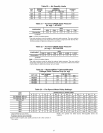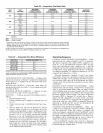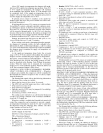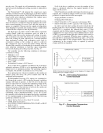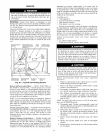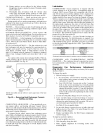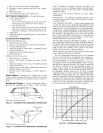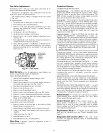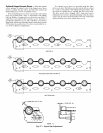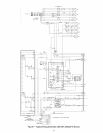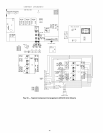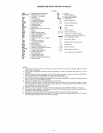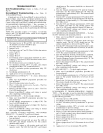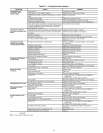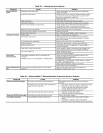
Gas Valve Adjustment
NATURAL GAS- The gas valve ()pens and closes in re-
sponse to the thermostat or limit control.
When power is supplied to valve terminals DI and C2, the
m;dn v_dve opens to its preset position.
The regular factory setting is stamped on the v;dve body
(3.3 in. wg).
To adjust regulator:
1. Set thermostat at setting for no call for heat.
2. Turn main gas valve to OFF position.
3. Remove l/s-in, pipe plug from manifold or gas v;dve
pressure tap connection. Install a suitable pressure-
measuring device.
4. Set main gas valve to ON position.
5. Set thennostat at setting to call for heat.
6. Remove screw cap covering regulator adjustment sclew
(see Fig. 56).
7. Turn adjustment screw clockwise to increase pressure or
counterclockwise to decrease pressure.
8. Once desired pressure is established, set thermostat set-
ting for no call for heat, turn off main gas valve, remove
pressure-measuring device, and replace I/s-in. pipe plug
and screw cap.
REGULATOR
..-----"ADJUSTMENT
SCREW
(REMOVE
COVER)
Fig. 56 -- Gas Valve
Main Burners -- For all applications, main burners are
factory set and should require no adjustment.
MAIN BURNER REMOVAL
1. Shut off (field-supplied) manual main gas v;dve.
2. Shut off power to unit.
3. Remove unit control box access panel, burner section ac-
cess panel, and center post (see Fig. 4 and 5).
4. Disconnect gas piping from gas valve inlet.
5. Remove wires from gas valve.
6. Remove wires from rollout switch.
7. Remove sensor wire and ignitor cable from [GC board.
8. Remove 2 screws securing manifold bracket to basepan.
9. Remove 2 screws that hold the burner support plate
flange to the vestibule plate.
10. Lift burner assembly out of unit.
CLEANING AND ADJUSTMENT
1. Remove burner rack from unit as described in Main
Burner Removal section above.
2. Inspect burners, and if dirty, remove burners fiom rack.
3. Using a soft brush, clean burners and crossover port as
required.
4. Adjust spark gap. See Fig. 57.
5. Reinst_dl burners on rack.
6. Reinstall burner rock as described above.
Filter Drier- Replace whenever refrigerant system is
exposed to atmosphere.
Protective Devices
COMPRESSOR PROTECTION
Phase Protection -- On 48TJ016 and 020 units, the phase
monitor relay (PMR) will monitor the sequence of the 3-phase
electric_d system to provide phase reversal protection. The
PMR will also monitor the 3-phase voltage inputs to provide
phase loss protection for the 3-phase device.
Overcurrent -- Each compressor has internal line break motor
protection, except the circuit no. 1 on the 48TJ028 units. Com-
pressor no. 1 on the 48TJ028 unit uses an electronic module,
located with the compressor junction box, to provide motor
protection. This electronic module monitors winding and dis-
chtuge temperatures. If these temperatures reach the trip val-
ues, the module interrupts the control line and causes the
compressor to switch off.
Crankcase Heater -- Only the 48TJ028 unit and units with
optional MoistureMiSer TM dehumidification system are
equipped with a 70-watt crankcase heater to prevent absorption
of liquid refrigerant by oil in the crankcase when the compres-
sor is idle. The crankcase heater is energized whenever there is
a main power to the unit and the compressor is not energized.
I IMPORTANT: After a prolonged shutdown or servicing, I
energize the crankcase heaters for 24 houLs before stmt-
I
ing the compressors.
Compressor Lockout -- If any of the safeties (high-pressure,
low-pressure, freeze protection thermostat, compressor internal
thermostat) trip, or if there is loss of power to the compressors,
the cooling lockout (CLO) will lock the compressors off. To
reset, manually move the thermostat setting.
EVAPORATOR-FAN MOTOR PROTECTION -- A man-
ual reset, calibrated trip, magnetic circuit bleaker protects
against overcurrent. Do not bypass connections or increase the
size of the breaker to correct trouble. Determine the cause and
correct it before resetting the breakel:
CONDENSER-FAN MOTOR PROTECTION -- Each
condenser-fan motor is internally protected against
overtemperature.
HIGH-PRESSURE AND LOW-PRESSURE SWITCHES --
If either switch trips, or if the compressor overtemperature
switch activates, that refrigerant circuit will be automatically
locked out by the CLO. To reset, manually move the thermo-
stat setting.
FREEZE PROTECTION THERMOSTAT (FPT) -- An FPT
is located on the top and bottom of the evaporator coil. They
detect frost build-up and turn off the compressol: allowing the
coil to clem: Once the frost has melted, the compressor can be
reenergized by resetting the compressor lockout.
Relief Devices -- All units have relief devices to protect
against damage from excessive pressures (i.e., fire). These
devices protect the high and low side.
Control Circuit, 24-7--This control circuit is pro-
tected against overcurrent by a 3.2 amp circuit breakec
Bre;_ker can be reset. If it trips, determine cause of trouble
before resetting. See Fig. 58 and 59 for typical wiring diagram
and component ;urangement.
Replacement Parts -- A complete list of replacement
parts may be obtained from any Carrier distributor upon
request.
Diagnostic IGC Control LEDs-- The IGC bom'd
has LEDs for diagnostic purposes. Refer to Troubleshooting
section on page 48.
43



